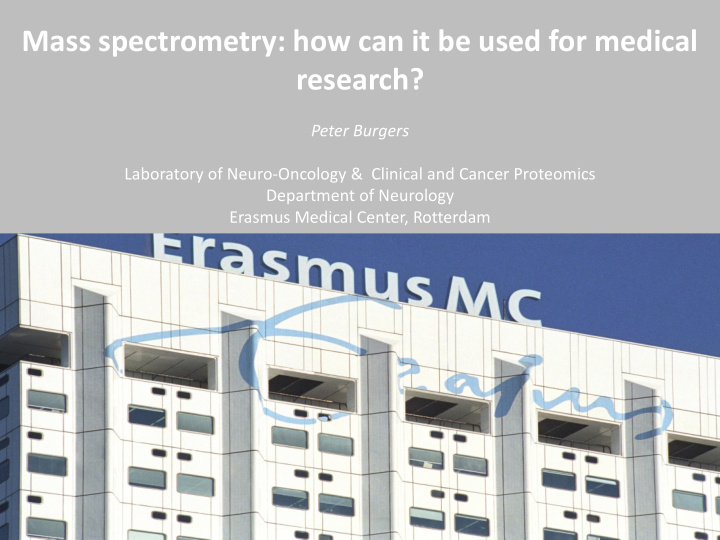



Mass spectrometry: how can it be used for medical research? Peter Burgers Laboratory of Neuro-Oncology & Clinical and Cancer Proteomics Department of Neurology Erasmus Medical Center, Rotterdam
Proteomics Proteomics aims to describe or explain biological phenomena in terms of qualitative and/or quantitative changes in proteins of cells and extra cellular biological materials Why is proteomics important? Neurodegenerative disorders and brain tumors • Alzheimer’s Disease • Parkinson’s Disease • Glioma • Multiple sclerosis Proteins play a key role
Mass spectrometry A mass spectrometer is a device which converts neutral molecules into ions and then sorts these ions according m 2 to their masses m 1 m 3 abundance mass
Gravitational field h m
U pot = m.g.h h m
E kin = ½.m.v 2
U pot = E kin m.g.h = ½.m v 2 m.g.h = ½.m v 2 g.h = ½. v 2 √ 2.h t = g There is no m in this equation Galileo Galileï (1564-1642)
Electric field + h m - - - - - - - - - - - - - - - - V
+ U pot = e.V h m - - - - - - - - - - - - - - - - V
+ E kin = ½.m.v 2 - - - - - - - - - - - - - - - - V
U pot = E kin e.V = ½.m v 2 √ m t = h 2eV Now there is an m in this equation!!!
Time-of-Flight + + ½mv 2 = eV = constant Mass 1,000: v = 7 x 10 4 m/s or 250,000 km/hr
Founder of Mass Spectrometry: Sir J.J. Thomson 1905
Calutron F.O.M. (Amsterdam) c. 1950
Control panels and operators for calutrons at Oak Ridge
AEI MS902 c. 1972
Era of mass spectrometry 1930 - 1950 nuclear physics 1950 - 1990 chemistry: GC-MS 1990 - life sciences: ESI and MALDI 2002 Nobel prize: Fenn, Tanaka "for their development of soft desorption ionisation methods for mass spectrometric analyses of biological macromolecules" Physics chemistry life sciences
Applications of Mass Spectrometry Forensic sciences (murder cases) Doping (Olympic games) Art (forgeries) Historical issues (Shroud of Turin) Life sciences (proteomics, metabolomics) Nuclear physics (isotope enrichment) Enriching 28 Si for quantum computing Sniffing smuggled money Flavors ans fragrances (coffee, perfume) Bacterial identification Antibiotic resistance screening
Volume 2 Issue 8 Table of Contents: How the Legal and Medical Systems failed Patricia and Ryan Stallings
How mass spectrometry freed a mother convicted of baby murder The Patricia Stallings case
The Stallings Case July 7 1989 Ryan becomes ill July 9 1989 Ryan is hospitalized July 12 1989 Ethylene glycol found in Ryan’s blood HO-CH 2 -CH 2 -OH How measured ? Gas chromatography : retention index
The Stallings Case, ctd Ryan discharged from hospital foster home July 17 1989 Sept 1 1989 Mrs Stallings feeds Ryan by bottle Sept 4 1989 Ryan dies Mrs Stallings charged with murder Sentenced to life imprisonment
The Stallings Case, an unexpected turn of events David Jr. is born foster home April 1990 April 1990 Diagnosis: Methylmalonic Acidemia (MMA) Byproducts: organic acids: CH 3 CH 2 COOH How measured: Gas chromatography – mass spectrometry
Gas Chromatography – Mass Spectrometry Mass spectrometer Mass spectrum Identification
31 45
Mass spectrometry in life sciences Mass spectrometry (MS) Ion source extraction mass analysis
Ionization techniques for biomolecules • Ablation (Matrix-assisted laser desorption/ionization) MALDI Crystal gas-phase • Nebulization (Electrospray Ionization) ESI Liquid gas-phase
LC-ESI-Orbitrap • High resolution • Very sensitive • Low throughput • High speed sequencing
Mass measurements Mass accuracy: < + or - 0.1 ppm systematic error Mass precision: ± 0.5 ppm experimental uncertainty Measured mass 1633.7234 ± 0.0008 (30 measurements) Real mass 1633.7236 Accurate : telling the truth Precise : telling the same story over and over again
http://www.mathsisfun.com/accuracy-precision.html
Low Accuracy High Precision
Low Accuracy High Accuracy High Precision Low Precision
High Accuracy Low Accuracy High Accuracy High Precision High Precision Low Precision
The principle of protein identification by MS Objective: generate a unique set of numbers for any protein 1. Peptide Mass Fingerprinting (PMF) Enzyme specific peptides Peptide masses Protein sequence ALALR MRRAALWLWLCRALALRL 563.326 Enzymatic GIVEECCFR QPVDERGIVEECCFRATG 1053.457 TGASQSLLDR ASQRTGASQSLLDRLVAF 1187.607 LVAFMLYRMWLK hydrolysis MLYRMWLKVGLIFAVCLVL 1323.856 LEEPKQANGGAYQKPR EEPKQANGGAYQKPRDE 1953.185 DEGSYSLEEPKQANGGAYQKPTK GSYSLEEPKQANGGAYQK 2. Peptide fragmentation (MS/MS) GIVEECCFR GIVEECCFR Sequencing: b-ions y-ions
A549 cell line 1198.7098 No virus 1189.6154 1180.6237 Influenza intensity 1186.6815 24hrs mass
The principle of protein identification by MS Objective: generate a unique set of numbers for any protein 1. Peptide Mass Fingerprinting (PMF) Enzyme specific peptides Peptide masses Protein sequence ALALR MRRAALWLWLCRALALRL 563.326 Enzymatic GIVEECCFR QPVDERGIVEECCFRATG 1053.457 TGASQSLLDR ASQRTGASQSLLDRLVAF 1187.607 LVAFMLYRMWLK hydrolysis MLYRMWLKVGLIFAVCLVL 1323.856 LEEPKQANGGAYQKPR EEPKQANGGAYQKPRDE 1953.185 DEGSYSLEEPKQANGGAYQKPTK GSYSLEEPKQANGGAYQK 2. Peptide fragmentation (MS/MS) GIVEECCFR GIVEECCFR Sequencing: b-ions y-ions
Calculating b and y ions b ions (N-term) (N-term residue +1) + Σ (residues) y ions (C-term) (C-term residue + 19) + Σ (residues)
Calculate b and y ions for HPDYSVVLLLR MH+ = 1311.7419 b ions y ions
Calculate b and y ions for HPDYSVVLLLR MH+ = 1311.7419 b ions y ions 138 175 235 288 350 401 513 514 600 613 699 712 798 799 911 962 1024 1077 1137 1174 1293 1311 (+ 18 = 1311)
Conclusions Mass spectrometry has evolved A lot of challenges Development methodology 1 10 -12 cytokine albumin
Abundance of proteins relative 10 25 molecules / L 1 molecule / L water yM zM aM fM pM nM µM mM M glucose drugs nucleic Physiological acids salt ...................... cytokine albumin proteins
Abundance of proteins absolute 1 molecule (1/N) ymol zmol amol fmol pmol nmol µmol glucose drugs nucleic Physiological acids salt ...................... cytokine albumin proteins
Proteomics and mass spectrometry: a marriage made in heaven
Recommend
More recommend